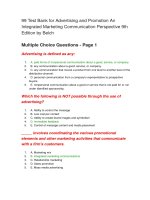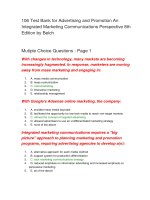Lecture Advertising and promotion: An integrated marketing communications perspective (10/e): Chapter 1 - George E. Belch, Michael A. Belch
Bạn đang xem bản rút gọn của tài liệu. Xem và tải ngay bản đầy đủ của tài liệu tại đây (909.9 KB, 24 trang )
Chapter 1
An Introduction
to Integrated
Marketing
Communication
s
Copyright © 2015 McGraw-Hill Education. All rights reserved. No reproduction or distribution without the prior written consent of
McGraw-Hill Education.
Marketing
Activity, set of institutions, and processes for
creating, communicating, delivering and
exchanging offerings that have value for:
Customers, clients, partners, and society at large
Exchange: Involves parties with:
Something of value to one another
Desire and ability to give up something to the other
party
Way to communicate with each other
Copyright © 2015 McGraw-Hill Education. All rights reserved. No reproduction or distribution without the prior written consent
of McGraw-Hill Education.
2
Marketing Mix
Product, price, place, and promotion
To develop an effective marketing mix, marketers
must:
Be knowledgeable about the issues and options of
each element of the mix
Know how to combine the elements to form an
effective marketing program
Analyze the market and use the data to develop the
marketing strategy and mix
Copyright © 2015 McGraw-Hill Education. All rights reserved. No reproduction or distribution without the prior written consent
of McGraw-Hill Education.
3
Integrated Marketing Communications
(IMC)
Coordinate various promotional elements and other marketing
activities that communicate with a firm’s customers
Recognizes the added value of a comprehensive plan that:
•Evaluates the strategic roles of a variety of communication
disciplines
•Combines the disciplines to provide clarity, consistency, and
maximum communications impact
Ensures all marketing and promotional activities project a
consistent, unified image
Copyright © 2015 McGraw-Hill Education. All rights reserved. No reproduction or distribution without the prior written consent
of McGraw-Hill Education.
4
Integrated Marketing Communications
(IMC)
Criticism Insideout marketing approach
Packs promotional mix elements together, making
them look and sound alike
Contemporary perspective
Goal Generate shortterm financial returns and
build longterm brand and shareholder value
Views IMC ongoing strategic business process
Copyright © 2015 McGraw-Hill Education. All rights reserved. No reproduction or distribution without the prior written consent
of McGraw-Hill Education.
5
Growing Importance of IMC
Strategically integrates the various communications
functions
Avoids duplication and takes advantage of synergy
among promotional tools
Develops more efficient and effective marketing
communications programs
Changing environment
•Evolution to micromarketing
•Consumers’ unresponsiveness to traditional advertising
•Changing rules of marketing
Copyright © 2015 McGraw-Hill Education. All rights reserved. No reproduction or distribution without the prior written consent
of McGraw-Hill Education.
6
Integrated Marketing Communications
(IMC): Role in Branding
Helps develop and sustain brand identity and
equity
Recognizes the need for companies to
connect with consumers based on trust,
transparency, and authenticity
Copyright © 2015 McGraw-Hill Education. All rights reserved. No reproduction or distribution without the prior written consent
of McGraw-Hill Education.
7
Figure 1.2 Elements of the
Promotional Mix
Copyright © 2015 McGraw-Hill Education. All rights reserved. No reproduction or distribution without the prior written consent
of McGraw-Hill Education.
8
Advertising Classifications
Copyright © 2015 McGraw-Hill Education. All rights reserved. No reproduction or distribution without the prior written consent
of McGraw-Hill Education.
9
Direct Marketing
Communicating directly with target customers to
generate a response and/or a transaction
Involves:
Database management
Direct selling
Telemarketing
Directresponse advertising
Encourages the consumer to purchase directly from the
manufacturer
Copyright © 2015 McGraw-Hill Education. All rights reserved. No reproduction or distribution without the prior written consent
of McGraw-Hill Education.
10
Digital/Internet Marketing
Interactive media
• Allow users to participate in and modify the form and
content of the information they receive in real time
Social media
• Online means of communication and interactions used to
create, share, and exchange content
Mobile marketing
• Messages delivered are specific to a consumer’s location
or consumption situation
Copyright © 2015 McGraw-Hill Education. All rights reserved. No reproduction or distribution without the prior written consent
of McGraw-Hill Education.
11
Sales Promotion
Copyright © 2015 McGraw-Hill Education. All rights reserved. No reproduction or distribution without the prior written consent
of McGraw-Hill Education.
12
Publicity
Nonpersonal communications regarding an
organization, product, service, or idea not directly
paid for or run under identified sponsorship
Advantage
High credibility and low cost
Disadvantages
Not always under the control of an organization
Negative stories are highly damaging
Copyright © 2015 McGraw-Hill Education. All rights reserved. No reproduction or distribution without the prior written consent
of McGraw-Hill Education.
13
Public Relations
Evaluates public attitudes
Identifies policies and procedures of an individual
or organization with the public interest
Goal Establish and maintain a positive image
among various publics
Copyright © 2015 McGraw-Hill Education. All rights reserved. No reproduction or distribution without the prior written consent
of McGraw-Hill Education.
14
Personal Selling
Persontoperson communication in which seller
attempts to assist and/or persuade prospective
buyers to:
Purchase a company’s product
Act on an idea
Allows seller to tailor messages to the customer’s
specific needs or situation
Involves immediate and precise feedback
Copyright © 2015 McGraw-Hill Education. All rights reserved. No reproduction or distribution without the prior written consent
of McGraw-Hill Education.
15
Contact or Touch Point
Every opportunity a customer has to see or hear
about a company and/or its brands or have an
encounter or experience with it
Categories
Company created
Intrinsic
Unexpected
Customerinitiated
Copyright © 2015 McGraw-Hill Education. All rights reserved. No reproduction or distribution without the prior written consent
of McGraw-Hill Education.
16
Figure 1.5 IMC Audience Contact
Tools
Copyright © 2015 McGraw-Hill Education. All rights reserved. No reproduction or distribution without the prior written consent
of McGraw-Hill Education.
17
Figure 1.6 IMC Contact Points:
Control vs. Impact
Copyright © 2015 McGraw-Hill Education. All rights reserved. No reproduction or distribution without the prior written consent
of McGraw-Hill Education.
18
IMC Planning Process
Integrated marketing communications
management
• Planning, executing, evaluating, and controlling the use of
the promotional-mix elements to effectively communicate
with target audiences
Integrated marketing communications plan
• Developing, implementing, and controlling an organization’s
IMC program
Copyright © 2015 McGraw-Hill Education. All rights reserved. No reproduction or distribution without the prior written consent
of McGraw-Hill Education.
19
IMC Planning Model
Review of marketing plan
Analysis of promotional program situation and the communication process
Budget determination
Develop integrated marketing communications programs
Advertising
Direct
marketing
Digital/Internet
marketing
Sales
promotion
PR/publicity
Personal selling
Advertising
objectives
Directmarketing
objectives
Internet
marketing
objectives
Sales
promotion
objectives
PR/publicity
objectives
Personal-selling
objectives
Advertising
strategy
Directmarketing
strategy
Internet
marketing
strategy
Sales
promotion
strategy
PR/publicity
strategy
Personal-selling
strategy
Advertising
message &
media strategy
& tactics
Directmarketing
message &
media strategy
& tactics
Internet
message &
media strategy
& tactics
Sales promotion
message &
media strategy
& tactics
PR/publicity
message &
media strategy
& tactics
Sales message
strategy and
sales tactics
Integrate and implement marketing communications strategies
Monitor, evaluate, and control IMC Program
Copyright © 2015 McGraw-Hill Education. All rights reserved. No reproduction or distribution without the prior written consent
of McGraw-Hill Education.
20
Marketing Plan
Describes overall marketing strategy and programs
for an organization and includes:
Detailed situation analysis
Specific marketing objectives with timeframe and
mechanism for measuring performance
Selection of target market(s) and plans for the four
elements of the marketing mix
Program for implementing the marketing strategy
Process for monitoring and evaluating performance
Copyright © 2015 McGraw-Hill Education. All rights reserved. No reproduction or distribution without the prior written consent
of McGraw-Hill Education.
21
Promotional Program Situational
Analysis
Copyright © 2015 McGraw-Hill Education. All rights reserved. No reproduction or distribution without the prior written consent
of McGraw-Hill Education.
22
Analysis of Communication Process
Marketing objectives
• Determine what is to be accomplished by the overall
marketing program in terms of sales, market share, or
profitability
Communication objectives
• Determine what the firm seeks to accomplish with its
promotional program
• Stated in terms of:
• Nature of the message to be communicated
• Specific communication effects to be achieved
Copyright © 2015 McGraw-Hill Education. All rights reserved. No reproduction or distribution without the prior written consent
of McGraw-Hill Education.
23
Monitoring, Evaluation, and Control
Determining how well the program is:
Meeting communication objectives
Helping the firm accomplish its overall marketing
goals and objectives
Evaluating promotional program
results/effectiveness
Taking measures to control and adjust promotional
strategies
Copyright © 2015 McGraw-Hill Education. All rights reserved. No reproduction or distribution without the prior written consent
of McGraw-Hill Education.
24









